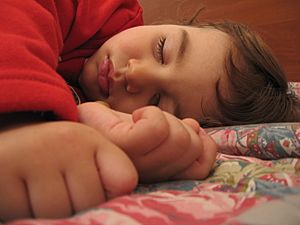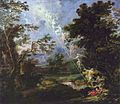Dream facts for kids
Dreams are like stories or pictures that your mind creates when you are sleeping. They can feel very real, almost like you are awake, even though you are actually asleep. Sometimes dreams are similar to things that happen in real life, but they can also be very strange and imaginative!
Sometimes, while you are dreaming, you might suddenly realize that you are dreaming. This cool experience is called a lucid dream. When this happens, you might even feel like you can control what happens in your dream! People who have lucid dreams often enjoy doing fun things they can't do in the real world, like flying or having superpowers.
Most people remember at least a little bit of their dreams, even if it's just a small part. Kids often remember their dreams very clearly. If you want to remember your dreams better, try writing down what happened in your dream right after you wake up. Many people keep a special "dream diary" to write about all their dreams.
Nightmares are dreams that can make you feel scared or shocked. They often involve things you might be afraid of in real life, like spiders or dark places. But even a dream that isn't about your fears can feel unpleasant. Nightmares can be caused by different things, such as feeling uncomfortable or in pain while you sleep, being sick, feeling stressed, or even eating a big meal right before bed.
People have many different ideas about why we dream and what our dreams mean. Everyone's dreams are unique! Some psychologists, who study the mind, believe that dreams show us what's happening in our unconscious mind. This is the part of your mind that works without you even thinking about it. Other people think that the people, places, and objects in dreams are like symbols for other things in your real life. For a long time, people have tried to understand dreams to learn from them, sometimes even using them to try and predict the future. Today, you can still find many books and websites that try to help people understand their dreams.
Contents
Ancient Ideas About Dreams
Long, long ago, people in ancient civilizations often thought that dreams were special messages from the gods. They also believed dreams could sometimes show them what would happen in the future, like a prophecy. However, they also knew that dreams could sometimes trick people or be confusing. Famous thinkers like Aristotle first thought dreams might be divine, but later he became more doubtful and didn't believe dreams came from the gods.
Modern Science and Dreams
Today, scientists focus more on how our bodies and brains work when we dream. They've learned a lot about different stages of sleep.
One important discovery was REM sleep, which stands for Rapid Eye Movement. This is a stage of sleep where your eyes move quickly, and it's when most vivid dreaming happens. There's also non-REM sleep. Researchers have studied people by waking them up during both REM and non-REM stages and asking them what they were thinking about. They found that what people remember from REM sleep is different from non-REM sleep.
Scientists are still learning about why we dream, but they know it's a normal and important part of sleep.
Do Animals Dream?
It seems that many animals, not just humans, also experience REM sleep and might dream! Scientific studies suggest that all mammals, like dogs, cats, and even elephants, have REM sleep. The amount of REM sleep can be different for different animals. For example, dolphins have very little REM sleep, while animals like the armadillo and the opossum have a lot.
Researchers have seen signs of dreaming in many mammals, including monkeys, dogs, cats, rats, and shrews. There have even been signs of dreaming in birds and reptiles. Sleeping and dreaming are closely connected. While scientists are still debating exactly why animals dream, it's clear that sleep is very important for all living things. Studies have shown that if animals don't get enough sleep, their bodies can start to have problems.
Some scientists believe that humans dream for similar reasons that other animals do. From a scientific point of view, dreams would need to help us in some way, or at least not harm us. One idea, called the "threat-simulation theory," suggests that dreams might have helped early humans prepare for dangers. By dreaming about scary situations, our brains might have practiced how to react to real threats, helping us survive.
Images for kids
-
A Dream of a Girl Before a Sunrise c. 1830–33 by Karl Bryullov (1799–1852)
-
Usha Dreaming Aniruddha (oleographic print) Raja Ravi Varma (1848–1906)
-
The Knight's Dream, 1655, by Antonio de Pereda
-
The cheshire cat, John Tenniel (1820–1914), illustration in Alice's Adventures in Wonderland, 1866 edition.
See also
 In Spanish: Ensueño para niños
In Spanish: Ensueño para niños















